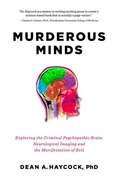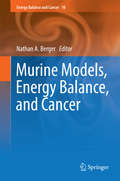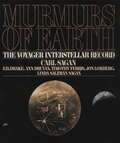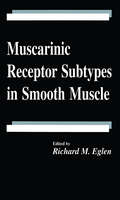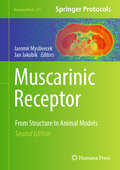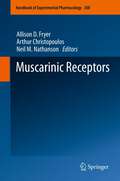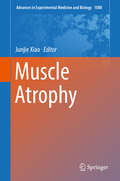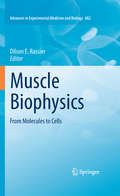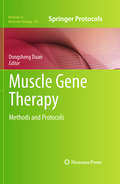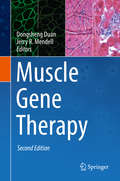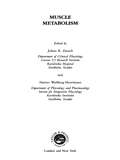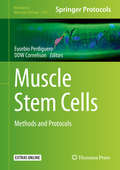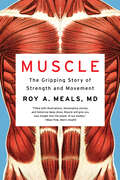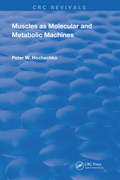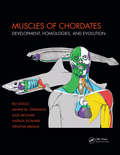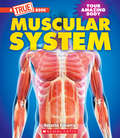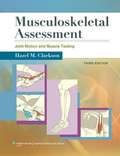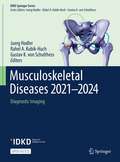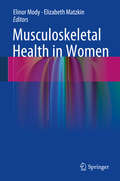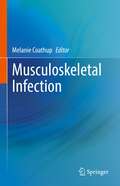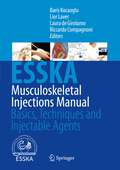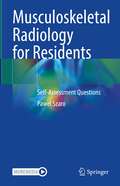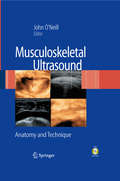- Table View
- List View
Murderous Minds: Neurological Imaging and the Manifestation of Evil
by Dean A. HaycockIs there a biological basis for evil? From neurological imaging to behavioral studies, Dean Haycock's account of the groundbreaking research reveals what scientists are learning about the psychopaths living among us. How many times have you seen a murder on the news or on a TV show like CSI: Crime Scene Investigation, and said to yourself, "How could someone do something like that?" Today, neuroscientists are imaging, mapping, testing and dissecting the source of the worst behavior imaginable in the brains of the people who lack a conscience: psychopaths. Neuroscientist Dean Haycock examines the behavior of real life psychopaths and discusses how their actions can be explained in scientific terms, from research that literally looks inside their brains to understanding how psychopaths, without empathy but very goal-oriented, think and act the way they do. Some don’t commit crimes at all, but rather make use of their skills in the boardroom. But what does this mean for lawyers, judges, psychiatrists, victims and readers--for anyone who has ever wondered how some people can be so bad. Could your nine-year-old be a psychopath? What about your co-worker? The ability to recognize psychopaths using the scientific method has vast implications for society, and yet is still loaded with consequences. 8 page color insert
Murine Models, Energy Balance, and Cancer
by Nathan A. BergerThis volume provides a transdisciplinary and translational review of many of the leading murine models used to study the mechanisms, mediators and biomarkers linking energy balance to cancer. It provides a review of murine models that should be of interest to basic, clinical and applied research investigators as well as nutrition scientists and students that work in cancer prevention, cancer control and treatment. The worldwide obesity pandemic has been extensively studied by epidemiologic and observational studies and even, in some cases, by randomized controlled trials. However, the development and control of obesity, its comorbidities and its impact on cancer usually occurs over such long periods that it is difficult, if not impossible to conduct randomized controlled trials in humans to investigate environmental contributions to obesity, energy balance and their impact on cancer. In contrast, model organisms, especially mice and rats, provide valuable assets for performing these studies under rigorously controlled conditions and in sufficient numbers to provide statistically significant results. In this volume, many of the leading and new murine models used to study the mechanisms and mediators linking cancer with obesity, sleep, exercise, their modification by environment and how they may continue to be used to further elucidate these relations as well as to explore preclinical aspects of prevention and/or therapeutic intervention are considered. This volume provides an important compilation and analysis of major experimental systems and principles for further preclinical research with translational impact on energy balance and cancer.
Murphy's Law
by Jim Russell* Whatever strikes a fan is not evenly distributed * Interchangeable parts won't * No good deed goes unpunished * A $300 color TV picture tube will protect a 10¢ fuse by blowing first * Leakproof seals will * Of two possible events, only the undesired one will occur * Any wire, pipe or board cut to exact length will be 1/8-inch too short * All warranties expire upon payment of the invoice * Nature always sides with the hidden flaw
Murray Gell-Mann and the Physics of Quarks (Classic Texts in the Sciences)
by Harald FritzschMurray Gell-Mann, Physics Nobel Prize Laureate in 1969 is known for his theoretical work on elementary particle physics and the introduction of quarks and together with H. Fritzsch the “Quantum Chromodynamics”. Based on four sections the Editor gives an overview on the work of Gell-Mann and his contributions to various aspects of the physics, related to quarks. His most important and influential papers were selected and reprinted so that the reader easily can check the original work of Gell-Mann.
Muscarinic Receptor Subtypes in Smooth Muscle (Handbooks In Pharmacology And Toxicology Ser. #42)
by Richard M. EglenThis book explores several subtypes of muscarinic receptors that modulate smooth muscle activity. Main topics include a classification of muscarinic receptors, biochemical responses that occur in smooth muscle, the role of muscarinic receptors in the function of gastrointestinal and genitourinary smooth muscle, and prejunctional muscarinic receptors in smooth muscle. Discussions cover the current state of research and are intended to generate further research into the design of novel therapeutics for disorders of smooth muscle function.
Muscarinic Receptor: From Structure to Animal Models (Neuromethods #211)
by Jaromir Myslivecek Jan JakubikThis second edition volume expands on the previous edition with updated protocols on basic techniques of radioligand binding, allosteric modulation, visualization and antibody use, and autoradiography and non-neuronal acetylcholine detection. The updated chapters also cover the latest fluorescent techniques including fluorescence anisotropy, and provide updates on current system measurements of heart contractility and gastrointestinal tract motility to provide readers with a comprehensive picture of current muscarinic receptors from molecular to systemic levels. In the Neuromethods series style, chapters include the kind of detail and key advice from the specialists needed to get successful results in your laboratory. Cutting-edge and authoritative, Muscarinic Receptors – From Structure to Animal Models, Second Edition is a valuable resource for scientists who are interested in using the latest methodologies to study muscarinic receptors quickly, easily, and correctly.
Muscarinic Receptors
by Neil M. Nathanson Arthur Christopoulos Allison D. FryerMuscarinic acetylcholine receptors have played a key role in the advancement of knowledge of pharmacology and neurotransmission since the inception of studies in these fields, and the effects of naturally occurring drugs acting on muscarinic receptors were known and exploited for both therapeutic and non-therapeutic purposes for hundreds of years before the existence of the receptors themselves was recognized. This volume presents a broad yet detailed review of current knowledge of muscarinic receptors that will be valuable both to long-time muscarinic investigators and to those new to the field. It describes the detailed insights that have been obtained on the structure, function, and cell biology of muscarinic receptors. This volume also describes physiological analyses of muscarinic receptors and their roles in regulating the function of the brain and of a variety of peripheral tissues. This volume shows how the study of muscarinic receptors continues to provide new and surprising insights not just to the cholinergic system but to the broad areas of neurobiology, cell biology, pharmacology, and therapeutics.
Muscle Atrophy (Advances in Experimental Medicine and Biology #1088)
by Junjie XiaoThe book addresses the development of muscle atrophy, which can be caused by denervation, disuse, excessive fasting, aging, and a variety of diseases including heart failure, chronic kidney diseases and cancers. Muscle atrophy reduces quality of life and increases morbidity and mortality worldwide. The book is divided into five parts, the first of which describes the general aspects of muscle atrophy including its characteristics, related economic and health burdens, and the current clinical therapy. Secondly, basic aspects of muscle atrophy including the composition, structure and function of skeletal muscle, muscle changes in response to atrophy, and experimental models are summarized. Thirdly, the book reviews the molecular mechanisms of muscle atrophy, including protein degradation and synthesis pathways, noncoding RNAs, inflammatory signaling, oxidative stress, mitochondria signaling, etc. Fourthly, it highlights the pathophysiological mechanisms of muscle atrophy in aging and disease. The book’s fifth and final part covers the diagnosis, treatment strategies, promising agents and future prospects of muscle atrophy. The book will appeal to a broad readership including scientists, undergraduate and graduate students in medicine and cell biology.
Muscle Biophysics
by Rassier Dilson J.EThe field of muscle biophysics has changed dramatically over the past years and new studies are reshaping the way we think muscles contract. Rapidly evolving techniques and advances are allowing us to understand the mechanics of individual molecules and cells as we could never do so before. This book, a contributed volume of the work of several current opinion leaders and well-known scientists in the field, will be unique for its rich list of authors as well as its updated, comprehensive inclusion of techniques in both cell and molecular biophysiology.
Muscle Gene Therapy
by Dongsheng DuanMuscle disease represents an important health threat to the general population. There is essentially no cure. Gene therapy holds great promise to correct the genetic defects and eventually achieve full recovery in these diseases. Significant progresses have been made in the field of muscle gene therapy over the last few years. The development of novel gene delivery vectors has substantially enhanced specificity and efficiency of muscle gene delivery. The new knowledge on the immune response to viral vectors has added new insight in overcoming the immune obstacles. Most importantly, the field has finally moved from small experimental animal models to human patients. This book will bring together the leaders in the field of muscle gene transfer to provide an updated overview on the progress of muscle gene therapy. It will also highlight important clinical applications of muscle gene therapy.
Muscle Gene Therapy: Methods And Protocols (Methods In Molecular Biology #709)
by Dongsheng Duan Jerry R. MendellAbout 7 million people worldwide are suffering from various inherited neuromuscular diseases. Gene therapy brings the hope of treating these diseases at their genetic roots. Muscle Gene Therapy is the only book dedicated to this topic. The first edition was published in 2010 when the field was just about to enter its prime time. The progress made since then has been unprecedented. The number of diseases that have been targeted by gene therapy has increased tremendously. The gene therapy toolbox is expanded greatly with many creative novel strategies (such as genome editing and therapy with disease-modifying genes). Most importantly, clinical benefits have begun to emerge in human patients. To reflect rapid advances in the field, we have compiled the second edition of Muscle Gene Therapy with contributions from experts that have conducted gene therapy studies either in animal models and/or in human patients. The new edition offers a much needed, up-to-date overview and perspective on the foundation and current status of neuromuscular disease gene therapy. It provides a framework to the development and regulatory approval of muscle gene therapy drugs in the upcoming years. This book is a must-have for anyone who is interested in neuromuscular disease gene therapy including those in the research arena (established investigators and trainees in the fields of clinical practice, veterinary medicine and basic biomedical sciences), funding and regulatory agencies, and patient community.
Muscle Metabolism
by Juleen R. Zierath Harriet Wallberg-HenrikssonDiabetes research on models comprising intact animal tissues, cell cultures and isolated pancreatic islets is essential for understanding the pathogenesis of the disease as well as the mechanisms responsible for the chronic complications associated with it. Enormous advances in the understanding of the development of diabetes and its prevention hav
Muscle Stem Cells: Methods and Protocols (Methods in Molecular Biology #1556)
by Eusebio Perdiguero Ddw CornelisonThis volume provides leading-edge protocols in the study of the molecular and cellular biology of muscle stem cells. Chapters detail current and updated methods for muscle stem cell isolation, culture, molecular analysis, cellular analysis, and reintroduction in vivo as well as protocols for studying myogenic stem cells in non-mammalian model systems. Written in the highly successful Methods in Molecular Biology series format, chapters include introductions to their respective topics, lists of the necessary materials and reagents, step-by-step, readily reproducible laboratory protocols, and tips on troubleshooting and avoiding known pitfalls. Authoritative and cutting-edge, Muscle Stem Cells: Methods and Protocols aims to ensure successful results in the further study of this vital field.
Muscle: The Gripping Story Of Strength And Movement
by Roy A. Meals MD“Filled with illustrations, illuminating stories, and historical deep dives, Muscle will give you new insight into the power of our bodies.” —Milan Polk, Men’s Health An entertaining illustrated deep dive into muscle, from the discovery of human anatomy to the latest science of strength training. Muscle tissue powers every heartbeat, blink, jog, jump, and goosebump. It is the force behind the most critical bodily functions, including digestion and childbirth, as well as extreme feats of athleticism. We can mold our muscles with exercise and observe the results. In this lively, lucid book, orthopedic surgeon Roy A. Meals takes us on a wide-ranging journey through anatomy, biology, history, and health to unlock the mysteries of our muscles. He breaks down the three different types of muscle—smooth, skeletal, and cardiac—and explores major advancements in medicine and fitness, including cutting-edge gene-editing research and the science behind popular muscle conditioning strategies. Along the way, he offers insight into the changing aesthetic and cultural conception of muscle, from Michelangelo’s David to present-day bodybuilders, and shares fascinating examples of strange muscular maladies and their treatment. Brimming with fun facts and infectious enthusiasm, Muscle sheds light on the astonishing, essential tissue that moves us through life.
Muscles as Molecular and Metabolic Machines (Routledge Revivals)
by Peter W. HochachkaFirst published in 1994, this book explores the paradigm of muscles as molecular and metabolic machines in which all structures and functions are exquisitely integrated and matched to each other. The analysis begins with a standard reductionist approach-reviewing the integrated machine parts. The key working components of the complete muscle machine are proteins (soluble, organelle, or membrane localized), and a conservative count indicates that today more than 100 such machine parts are known, essentially all occurring as cell specific isoforms. Random assortment of these machine parts or protein isoforms could generate an astronomical number of "muscle machines" and an equally enormous number of muscle fiber types. The question is, why aren't such large numbers ever seen?To attack this problem, the reductionist approach is complemented with an integrationist/adaptational one. Evidence is presented that the more highly specialized the muscle type, the further one moves from the above extreme; in the most highly specialized muscles, typically only one fiber type is found. It is argued that instead of random assortment of isoforms or machine parts, only specific and often unique combinations can work in appropriate fashion. A few established examples of this fundamental principle are reviewed, but emphasis is placed on the fact that we know dreadfully little about why this is so and what kinds of further studies are needed. The issue of why the very large numbers of fiber types theoretically possible are never even approximately realized has never before been addressed. Indeed, it is rarely recognized. Muscles as Molecular and Metabolic Machines is the first work of its kind on the subject.
Muscles of Chordates: Development, Homologies, and Evolution
by Rui Diogo Julia Molnar Janine M. Ziermann Natalia Siomava Virginia AbdalaChordates comprise lampreys, hagfishes, jawed fishes, and tetrapods, plus a variety of more unfamiliar and crucially important non-vertebrate animal lineages, such as lancelets and sea squirts. This will be the first book to synthesize, summarize, and provide high-quality illustrations to show what is known of the configuration, development, homology, and evolution of the muscles of all major extant chordate groups. Muscles as different as those used to open the siphons of sea squirts and for human facial communication will be compared, and their evolutionary links will be explained. Another unique feature of the book is that it covers, illustrates, and provides detailed evolutionary tables for each and every muscle of the head, neck and of all paired and median appendages of extant vertebrates. <P><P> Key Selling Features: <li>Has more than 200 high-quality anatomical illustrations, including evolutionary trees that summarize the origin and evolution of all major muscle groups of chordates <li>Includes data on the muscles of the head and neck and on the pectoral, pelvic, anal, dorsal, and caudal appendages of all extant vertebrate taxa <li>Examines experimental observations from evolutionary developmental biology studies of chordate muscle development, allowing to evolutionarily link the muscles of vertebrates with those of other chordates <li>Discusses broader developmental and evolutionary issues and their implications for macroevolution, such as the links between phylogeny and ontogeny, homology and serial homology, normal and abnormal development, the evolution, variations, and birth defects of humans, and medicine.
Muscular System (A True Book (Relaunch))
by Natasha VizcarraDiscover the main systems of our amazing human body with this new series of books!Our muscular system covers our bodies from head to toe. It helps keep us upright and gives us the power to stand, sit, run, smile, and more. Did you know that your muscles make up one-third of your body weight? Or that your tongue is made up of eight separate muscles? Learn all this and more in Muscular System.ABOUT THE SERIES:The human body is a complex—and remarkable—machine. Digesting our food. Pumping our blood. Walking, running, and dancing. It takes our many body systems working together to keep us alive and living our lives to the fullest. This set of A True Books offers an in-depth look at our amazing bodies—one system at a time. Interesting information is presented in a fun, friendly way—and in the simplest terms possible—giving students a "behind-the-scenes" look at how their bodies work.
Musculoskeletal Assessment: Joint Motion and Muscle Testing (Third Edition)
by Hazel M. ClarksonA comprehensive textbook that contains the principles and methodology of joint Range of Motion (ROM) and manual muscle strength evaluation in one volume.
Musculoskeletal Diseases 2021-2024: Diagnostic Imaging (IDKD Springer Series)
by Rahel A. Kubik-Huch Gustav K. von Schulthess Juerg HodlerThis open access book focuses on imaging of the musculoskeletal diseases. Over the last few years, there have been considerable advances in this area, driven by clinical as well as technological developments. The authors are all internationally renowned experts in their field. They are also excellent teachers, and provide didactically outstanding chapters. The book is disease-oriented and covers all relevant imaging modalities, with particular emphasis on magnetic resonance imaging. Important aspects of pediatric imaging are also included. IDKD books are completely re-written every four years. As a result, they offer a comprehensive review of the state of the art in imaging. The book is clearly structured with learning objectives, abstracts, subheadings, tables and take-home points, supported by design elements to help readers easily navigate through the text. As an IDKD book, it is particularly valuable for general radiologists, radiology residents, and interventional radiologists who want to update their diagnostic knowledge, and for clinicians interested in imaging as it relates to their specialty.
Musculoskeletal Health in Women
by Elinor Mody Elizabeth MatzkinRecent research indicates that gender differences in anatomy and physiology, endocrinology, hand eye co-ordination and motor development have an effect on the kinds of injuries incurred as a result of sporting activities. Since men and women have different responses to exercise; strength and conditioning programs should be modified for these differences. Musculoskeletal Health in Women was born out of a need to provide fitness advice tailored to women. For example, research has focused on correcting neuromuscular imbalances in women to prevent injuries. Increased abduction moment at the knee and balance problems have been found to be predictors of ACL injury. Muscle strengthening with special emphasis on the terminal knee extensors and hip abductors can improve these neuromuscular imbalances. Additionally, taping and bracing at the ankle may be helpful, particularly in women prone to certain injuries. Any discussion of women's sports injuries is only complete if it includes the Female Athlete Triad: energy availability (which is affected by eating disorders), osteoporosis, and menstrual function. Musculoskeletal Health in Women provides a fully-illustrated and comprehensive overview of all of these aspects and its multidisciplinary approach ensures that expertise is provided from disciplines such as psychiatry, physiatry, endocrinology, nutrition, rheumatology, orthopedics, physical therapy and radiology. These authors have worked with women athletes of all ilks and are well equipped to address a full spectrum of issues related to the musculoskeletal health of women. Musculoskeletal Health in Women will be of primary interest to women athletes and women embarking on a fitness regimen. Health professionals working in this area would also invariably benefit from the advice and guidance provided within these pages.
Musculoskeletal Infection
by Melanie CoathupThis book gathers international knowledge and contemporary clinical and scientific evidence on infections associated with the musculoskeletal system at a time when we are confronted with significant challenges and uncertainty. A key focus of the book is enhancing and advancing future discovery in the detection, prevention and treatment of musculoskeletal infection. This is an ideal book for physicians, surgeons, research scientists, university students, as well as medical and allied health students.
Musculoskeletal Injections Manual: Basics, Techniques and Injectable Agents
by Lior Laver Baris Kocaoglu Laura De Girolamo Riccardo CompagnoniThis book presents a comprehensive and updated overview of musculoskeletal injections with biologic and non-biologic injectable agents – a new trend of treatment in orthopaedics and sports medicine.This ESSKA book incorporates internal ongoing debates fostered by ESSKA U45 Committee and ESSKA’s Orthobiologics Initiative (ORBIT), which enroll a broad international group of dedicated clinicians and researchers. The topics covered mirror this fast evolving field which ranges from basic science knowledge to treatment options in sports traumatology. Renowned experts in the field examine and critically discuss each aspect, including existing controversies concerning indications and applications as well as the choice between biologic and non-biologic injections. Clear practical indications, subdivided by anatomical region and supported by a wealth of intra-procedural images, are aimed to support young surgeons in the application of musculoskeletal injections. Written by an international panel of clinicians and researchers, active in the field of orthobiology and sports medicine, this manual is an invaluable reference tool for all those involved in injectional therapies and sports traumatology.
Musculoskeletal Radiology for Residents: Self-Assessment Questions
by Pawel SzaroThis book allows residents and specialists in radiology to assess knowledge about musculoskeletal radiology. Most of the book's questions, stemming from the author’s experience of teaching residents in radiology at Sahlgrenska University Hospital in Gothenburg, Sweden, are very practical and often based on differential diagnosis, which is crucial in musculoskeletal radiology. Problem-based learning is useful in deep learning and allows a better understanding of pathological processes in the bones, joints, tendons, and muscles. The questions focus on clinical problems encountered during radiological examinations like MRI (the most fascinating and difficult one for residents), CT, ultrasound, or x-rays, and are intended to stimulate the daily evaluation of examinations. The book, enriched by videos as electronic supplementary material, is written for practitioners who evaluate examinations in musculoskeletal radiology. The information contained in the book is up-to-date and consistent with the results of the current scientific researches, which can be found under the answer to each question in the form of a concise summary. The current proposal will fill a gap in the radiological literature in comprehensive self-assessment of musculoskeletal radiology and can be used by residents and young specialists.
Musculoskeletal Ultrasound
by John M. O'NeillProper ultrasound examination and interpretation hinges on thorough knowledge of the relevant anatomy, artifacts, and technique. This book provides an excellent foundation by going beyond pathology and concentrating on these fundamentals. Basic physics and artifact recognition and prevention are outlined. Chapters review essential anatomy and include images and tables that highlight relevant bones, ligaments, tendons, muscles, and nerves. Sites of attachment and the best positions for examination are also noted. Technique is presented via a three-tiered approach and photographs of patients in the transducer position are matched with the resulting ultrasound images and complementary anatomical overlays.
